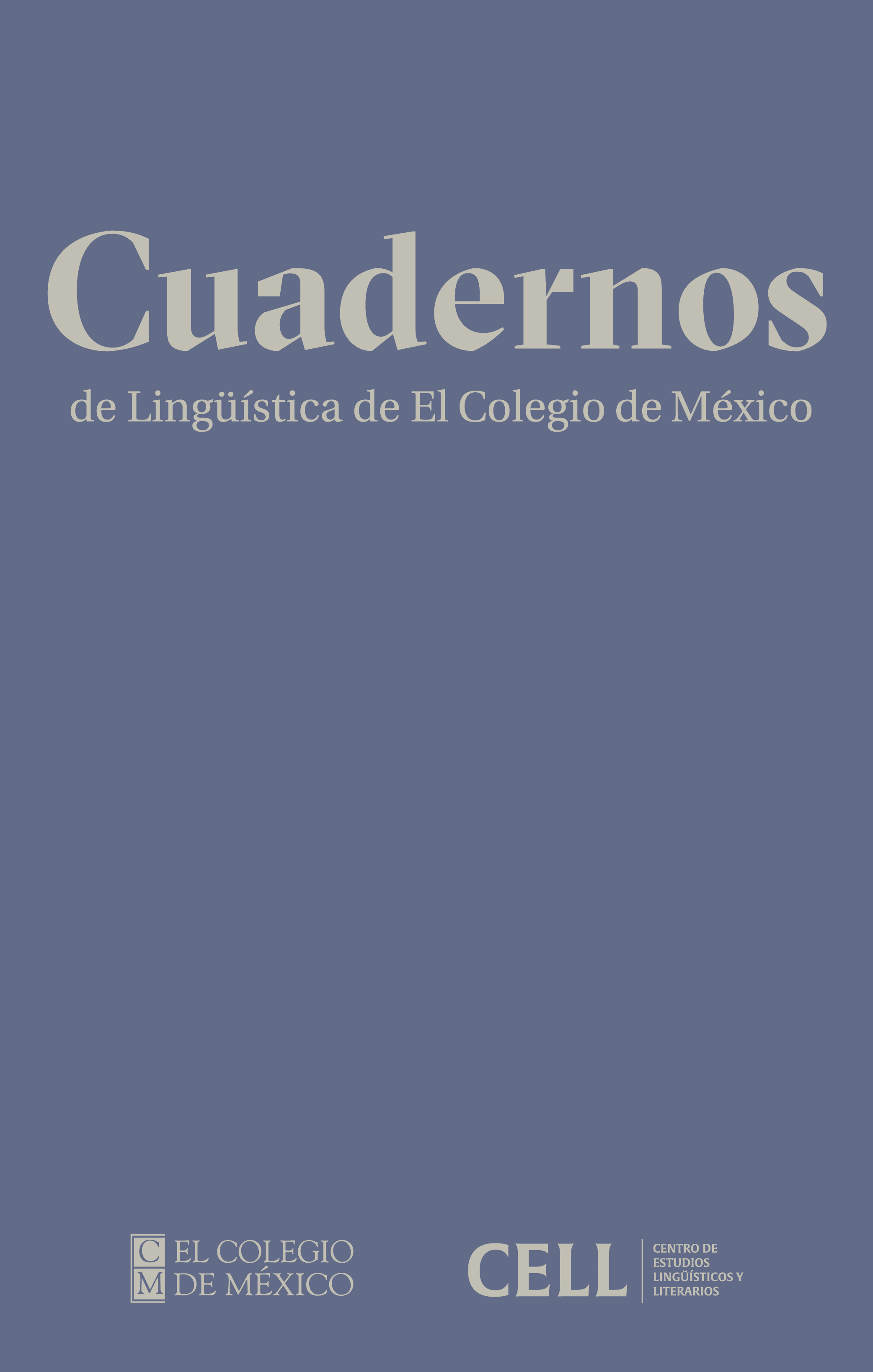Adpositions in three Oto-Manguean languages
DOI:
https://doi.org/10.24201/clecm.v10i00.272Keywords:
non-predicative adpositional phrases, predicative adpositional phrases, specific adpositional phrases, affixes, clitics, free morphemes, predicative nucleus, main verbAbstract
This paper describes the system of adpositions in three Otomanguean languages (Mazahua, Mazatec and Amuzgo) and shows that syntactically these phrases can be non-predicative, predicative and specific. In some cases, adpositional phrases do not contribute substantially to the meaning of the clause and, in others, they do so at the level of the predicate and its arguments, or they only have scope over the predicate. The analysis considers both the internal and external syntax of the adpositional phrases. The internal syntax states that adpositions can be realized in these languages as affixes, clitics or free morphemes; some of these function as predicative nuclei, therefore, they contribute in two ways to the meaning of the clause: with the meaning expressed by the nuclear adposition itself and with the internal argument they require. On the other hand, the analysis of the external syntax focuses on determining whether or not the adpositional phrases are governed by the main verb.
Downloads
References
Agee, Daniel M. 1993. Modal clitics in San Jerónimo Mazatec. SIL-Mexico Workpapers, 10. 1-28.
Ameka, Felix K. & Levinson, Stephen C. 2007. The typology and semantics of locative predicates: postural, positional and other beasts (Introduction to a special volume). Linguistics 45(5). 847-871. https://doi.org/10.1515/LING.2007.025 DOI: https://doi.org/10.1515/LING.2007.025
Apóstol, Jair. 2014. Clases flexivas verbales en el amuzgo de Xochistlahuaca, Guerrero. Ciudad de México: Centro de Investigaciones y Estudios Superiores en Antropología Social. (Tesis de maestría.)
Arka, I Wayan. 2014. Locative-related roles and the argument-adjunct distinction in Balinese. Linguistic Discovery 12(2). 56-84. https://10.1349/PS1.1537-0852.A.446 DOI: https://doi.org/10.1349/PS1.1537-0852.A.446
Bresnan, Joan. 1982. Control and complementation. Linguistic Inquiry 13(3). 343-434. https://www.jstor.org/stable/4178286
Campbell, Lyle. 1996. American Indian languages. The historical linguistics of Native America. Nueva York: Oxford University Press. DOI: https://doi.org/10.1093/oso/9780195094275.001.0001
Creissels, Denis. 2014. Cross-linguistic variations in the treatment of beneficiaries and the argument vs. adjunct distinction. Linguistic Discovery 12(2). 41-55. 0.1349/PS1.1537-0852.A.445 DOI: https://doi.org/10.1349/PS1.1537-0852.A.445
Dryer, Matthew. S. 2013. Order of adposition and noun phrase. En Dryer, Matthew S. & Haspelmath, Martin (eds.), The world atlas of language structures (online). Leipzig: Max Planck Institute for Evolutionary Anthropology.
Ernst, Thomas. 2002. The syntax of adjuncts. Cambridge: Cambridge University Press.
Forker, Diana. 2014. A canonical approach to the argument/adjunct distinction. Linguistic Discovery 12(2). 27–40. 10.1349/PS1.1537-0852.A.444 DOI: https://doi.org/10.1349/PS1.1537-0852.A.444
García Zúñiga, H. Antonio; Hernández Hernández, Natalia; Ortiz Villegas, Alejandra & Mora Bustos, Armando. 2019. Adposiciones y sistemas mixtos en tres lenguas otomangues. (Ponencia presentada en Seminario: Diacronía y adposiciones: origen y evolución. Universidad de Sonora.)
Gärtner, Hans-Martin; Law, Paul & Sabel, Joachim (eds.). 2006. Clause structure and adjuncts in Austronesian languages. Berlín: Mouton de Gruyter. DOI: https://doi.org/10.1515/9783110922974
Goldberg, Adele E. & Ackerman, Farrell. 2001. The pragmatics of obligatory adjuncts. Language 77(4). 798-814. https://www.jstor.org/stable/3086848 DOI: https://doi.org/10.1353/lan.2001.0219
Guerrero, Lilián (ed.). 2019. Adposiciones y elementos de su tipo en lenguas de América. Ciudad de México: Universidad Nacional Autónoma de México.
Hagège, Claude. 2010. Adpositions. Oxford: Oxford University Press.
Hasselgård, Hilde. 2010. Adjunct adverbials in English. Cambridge: Cambridge University Press. DOI: https://doi.org/10.1017/CBO9780511676253
Haspelmath, Martin. 2003. Adpositions. En Frawley, William J. (ed.), International encyclopedia of linguistics, 39-41. Oxford: Oxford University Press.
Haspelmath, Martin. 2019. Indexing and flagging, and head and dependent marking. Te Reo 62(1). 93-115.
Haspelmath, Martin. 2014. Arguments and adjuncts as language-particular syntactic categories and as comparative concepts. Linguistic Discovery 12(2). 3-11. DOI:10.1349/PS1.1537-0852.A.442 DOI: https://doi.org/10.1349/PS1.1537-0852.A.442
Haspelmath, Martin. 2015. Defining vs. diagnosing linguistic categories: A case study of clitic phenomena. En Błaszczak, Joanna; Klimek-Jankowska, Dorota & Migdalski, Krzysztof (eds.), How categorical are categories? New approaches to the old questions of noun, verb, and adjective, 273–304. Berlín: Mouton De Gruyter. DOI: https://doi.org/10.1515/9781614514510-009
Hernández, Natalia. 2019. El sistema tonal en el amuzgo de San Pedro Amuzgos: interacción entre el tono de la base nominal y los clíticos. Ciudad de México: Centro de Investigaciones y Estudios Superiores en Antropología Social. (Tesis de maestría.)
Jolly, Julia. 1991. Prepositional analysis within the framework of role and reference grammar. Nueva York: Peter Lang.
Jolly, Julia. 1993. Preposition assignment in English. En Van Valin, Robert. (ed.), Advances in role and reference grammar, 275-310. Ámsterdam:John Benjamins. DOI: https://doi.org/10.1075/cilt.82.08jol
Katz, Jerrold J. & Postal, Paul. 1964. An integrated theory of linguistic descriptions. Cambridge: Massachusetts Institute of Technology.
Knapp, Michael H. 2013. Doctrina y enseñanza en la lengua Mazahua. Estudio filológico y edición interlineal del texto bilingües de Nájera Yanguas. Ciudad de México: Instituto Nacional de Lenguas Indígenas.
Kroeger, Paul. 2008. Analyzing syntax. A lexical-functional approach. Cambridge: Cambridge University Press.
Kurzon, Dennis & Adler, Silvia. 2008. Adpositions: pragmatic, semantic and syntactic perspectives. Ámsterdam: John Benjamins. DOI: https://doi.org/10.1075/tsl.74
Levinson, Stephen C. & Wilkins, David P. 2006. Grammars of space. Explorations in cognitive diversity. Cambridge: Cambridge University Press. DOI: https://doi.org/10.1017/CBO9780511486753
Libert, Alan R. 2006. Ambipositions. (LINCOM Studies in Language Typology). Múnich: Lincom Europa.
Libert, Alan R. 2013. Adpositions and other parts of speech. Frankfurt: Peter Lang. DOI: https://doi.org/10.3726/978-3-653-03682-4
Lizárraga, Glenda & Mora-Bustos, Armando. 2015. Estructura gramatical de los adjuntos. Estudios de Lingüística Aplicada 61. 225-252. https://doi.org/10.22201/enallt.01852647p.2015.61.157
Mora-Bustos, Armando. 2022. Predicados no nucleares en mazahua (otomangue). Lengua y Sociedad 21(2). 149-176. http://dx.doi.org/10.15381/lengsoc.v21i2.23233 DOI: https://doi.org/10.15381/lengsoc.v21i2.23233
Ortiz Villegas, Alejandra; Mora-Bustos, Armando & García Zúñiga, H. Antonio. 2018. Sistema de demostrativos en tres lenguas otomangues. (Ponencia presentada en el XV Encuentro Internacional de Lingüística en el Noroeste. Universidad de Sonora.)
Ortiz Villegas, Alejandra; García Zúñiga, H. Antonio & Mora-Bustos, Armando. 2018. Sistema de pronombres personales en cuatro lenguas otomangues. (Ponencia presentada en Symposium on American Indian Languages. Universidad de Ottawa, Canadá.)
Ortiz Villegas, Alejandra; Hernández Hernández, Natalia; Mora-Bustos, Armando & García Zúñiga, H. Antonio. 2021. Sistema locativo en tres lenguas otomangues. Anales de Antropología 55(2). 125-141. https://doi.org/10.22201/iia.24486221e.2021.77971 DOI: https://doi.org/10.22201/iia.24486221e.2021.77971
Pacchiarotti, Sara & Zúñiga, Fernando (eds.). 2022. Applicative morphology: neglected syntactic and non-syntactic functions. (Trends in linguistics series). Berlín: De Gruyter. DOI: https://doi.org/10.1515/9783110777949
Pike, Kenneth. 1948. Tone language. Michigan: University of Michigan.
Smith-Stark, Thomas & Tapia, Fermín. 1984. Los tonos del amuzgo de San Pedro Amuzgos. Anales de Antropología 21. 199-220. https://doi.org/10.22201/iia.24486221e.1984.1.15916
Tallerman, Maggie. 2009. Understanding syntax. Londres: Hodder Arnold.
Van Valin, Robert D. & LaPolla, Randy J. 1997. Syntax: structure, meaning and function. Cambridge: Cambridge University Press. DOI: https://doi.org/10.1017/CBO9781139166799
Van Valin, Robert D. 2005. Exploring the syntax-semantics interface. Cambridge: Cambridge University Press. DOI: https://doi.org/10.1017/CBO9780511610578.001
Zwicky, Arnold M. 1992. Jottings on adpositions, case inflections, government, and agreement. En Brentari, Diane; Larson, Gary N. & MacLeod, Lynn A. (eds.), The joy of grammar. A festschrift in honor of James D. McCawley, 369-383. Ámsterdam: John Benjamins. DOI: https://doi.org/10.1075/z.55.23zwi
Published
How to Cite
-
Abstract400
-
PDF (Español)199
-
XML (Español)7
-
EPUB (Español)18
-
Kindle (Español)81
-
MP3 (Español)1
Issue
Section
License
Copyright (c) 2023 Armando Mora Bustos, Alejandra I. Ortiz Villegas, H. Antonio García Zúñiga , Natalia Hernández Hernández

This work is licensed under a Creative Commons Attribution-NonCommercial-NoDerivatives 4.0 International License.
Authors retain copyright of their work and are free to disseminate it, make copies for any use, and/or deposit in any repository or archive of their choice, but they grant Cuadernos de Lingüística de El Colegio de México the right to publish the work for the first time. Authors agree to acknowledge Cuadernos de Lingüística de El Colegio de México as the site of original publication of their article / note / review through proper citation.
Articles appearing in Cuadernos de Lingüística de El Colegio de México are made available to readers under a Attribution-NonCommercial-NoDerivatives 4.0 International.









